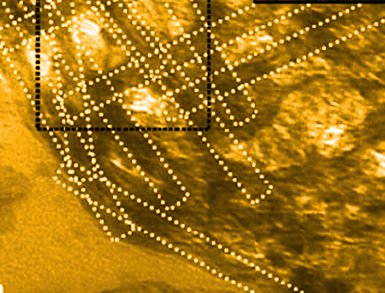Bioorganic–Inorganic Nanocomposites
Self-organization processes involving chemical building blocks are the basis for many biological processes and are increasingly of interest in the field of materials synthesis, for example in the production of highly ordered nanocomposites or high-porosity materials with special properties. In the journal Angewandte Chemie, Bruno Alonso and Emmanuel Belamie from the Charles Gerhardt Institute in Montpellier (France) have introduced a novel, highly versatile approach to the large-scale synthesis of a new family of bioorganic–inorganic nanocomposites—with a previously unattainable degree of control over the composition and structure of the materials produced.
Nanocomposites are solid materials made of different substances, one of which is in the form of nanoparticles. The properties of the composites differ significantly from those of the pure individual components. Nanocomposites can also serve as “molds” for the production of porous substances. These have potential application in the areas of gas storage, catalysis, or materials separation.
Sol Generation
For their synthesis, the researchers chose to use a sol–gel process, a popular technique for the production of inorganic network structures. In the first step they needed to generate a sol: a suspension of finely divided nanoscopic particles in a solvent. Their challenge was to obtain co-suspension of the two different components, silicon dioxide precursors (siloxane oligomers) and chitin nanorods from shrimp shells (a renewable resource). However, these two components require different conditions to remain in stable suspensions without uncontrolled precipitation. The researchers produced an alcohol suspension by slowly replacing water with ethanol. Through slow removal of the solvent, a gel formed. Gels are gelatinous substances; they contain solid but loose, cross-linked, three-dimensional polymer structures.
Drying
The sol can be “poured” into a desired mold and dried or it can be spray-dried into spherical particles. This process results in a nanocomposite made of chitin rods that are fully embedded in a silicon dioxide matrix. The mechanism by which this occurs is based on a self-organized aggregation of the chitin molecules and weak attractive forces between chitin and siloxane oligomers.
The stability of the alcohol suspensions opens up a wide range of possibilities for the production of materials with controllable volume ratios, spatial arrangements, and morphologies. If a magnetic field is applied during preparation of the material, the chitin rods line up in parallel. If the nanocomposite is heated, the chitin rods can be burned off to leave behind cavities. This forms a highly porous material with interesting properties.

- Chitin–Silica Nanocomposites by Self-Assembly
B. Alonso, E. Belamie,
Angew. Chem. Int. Ed. 2010, 49.
DOI: 10.1002/anie.201002104 - B. Alonso, E. Belamie,
Angew. Chem. 2010, 122.
DOI: 10.1002/ange.201002104




